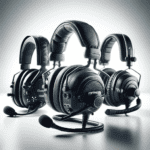Introduction
Choosing the right headset may seem like a trivial task, but it is crucial in ensuring an enhanced audio experience that aligns with your specific needs. Whether you are a gamer seeking immersion, a music enthusiast craving high-fidelity sound, or a professional seeking clear communication during virtual meetings, selecting the appropriate headset will make all the difference. This article will guide you through the myriad of options available and provide insights into the factors to consider when making this decision.
The Power of Sound: Why Choosing the Right Headset Matters

Sound has an incredible ability to shape our experiences. The right headset can transport us into virtual worlds, make us feel like we’re sitting front-row at a concert, or enable seamless communication with colleagues across continents.
On the other hand, using an ill-suited headset can result in distorted audio quality, discomfort during prolonged usage, or compromised communication. Therefore, it is paramount to invest time and consideration in finding the perfect headset that complements your unique requirements.
An Overview of Essential Factors to Consider
When embarking on your quest for the ideal headset, there are several critical factors to take into account. These include understanding different types of headsets available on the market and their respective advantages and disadvantages.
Additionally, identifying your specific needs and use cases such as gaming or professional applications will inevitably influence your decision-making process. Technical specifications such as frequency response range, impedance levels, and driver size also play a significant role in determining sound quality and performance.
To further enhance your audio experience, considering additional features like active noise cancellation (ANC) technology or Bluetooth connectivity is essential. But equally important is evaluating ergonomic aspects such as adjustability and comfort since prolonged usage should not compromise physical well-being.
Understanding Different Types of Headsets

Wired vs Wireless Headsets
Choosing between wired and wireless headsets is a fundamental decision that greatly impacts your overall listening experience. Wired headsets, while seemingly traditional, offer a range of advantages.
Firstly, they maintain a consistently high audio quality due to the direct connection established by the cable. This ensures minimal latency and interference, making them ideal for audiophiles or those who prioritize sound fidelity.
Additionally, wired headsets do not require charging and are typically more affordable than their wireless counterparts. On the other hand, wireless headsets provide a level of convenience that cannot be overlooked.
Freedom from cables allows for greater mobility and flexibility during use. Whether you’re engaging in intense gaming sessions or simply moving around while on a call, wireless headsets offer the ease of movement without any tangling wires to impede your activities.
However, it is important to note that wireless connectivity introduces potential issues such as signal interference and battery life limitations. When considering which type of headset is suitable for you, it’s imperative to ponder your specific needs in terms of mobility and convenience.
If you prioritize audio quality above all else and don’t mind being tethered by wires, then a wired headset may be the optimal choice for you. Conversely, if freedom of movement and convenience are paramount considerations in your usage scenario, then investing in a reliable wireless headset would undoubtedly enhance your experience.
Over-Ear vs On-Ear vs In-Ear Headsets
The physical design of headphones significantly affects comfort levels during prolonged use as well as the overall sound experience. Understanding the differences between over-ear, on-ear, and in-ear headsets allows you to make an informed decision based on personal preferences. Over-ear headphones envelop your ears entirely within cushioned ear cups.
They provide excellent noise isolation by effectively sealing off external sounds. This design ensures a more immersive experience, making it an ideal choice for audiophiles and gamers seeking a deep soundstage.
Over-ear headphones also tend to be more comfortable during extended use, as the weight is evenly distributed around the ears. On-ear headphones, as the name suggests, rest on the outer part of your ears.
They are generally lighter and more compact compared to over-ear models but may sacrifice some sound quality due to decreased noise isolation. While they may not provide complete noise cancellation, on-ear headphones are still a suitable option for those seeking portability and a balance between sound quality and comfort.
In-ear headphones, commonly known as earbuds or earphones, fit snugly inside your ear canal. They offer high portability due to their small size and are often included with mobile devices.
In-ear headphones are ideal for active individuals who require lightweight accessories that stay securely in place during vigorous physical activities. However, it’s important to note that in-ear headphones may not provide the same level of audio fidelity as their over- and on-ear counterparts due to their reduced driver size.
When deciding between over-ear, on-ear, or in-ear headsets, consider factors such as comfort preferences and desired sound quality. Understanding these distinctions will enable you to select a headset that caters precisely to your needs and ensures an enjoyable listening experience without compromising on convenience or style.
Gaming Headsets: Immerse Yourself in Surround Sound

For avid gamers seeking an immersive gaming experience, choosing a headset with surround sound capabilities is essential. Surround sound technology creates a three-dimensional audio environment, allowing you to accurately locate in-game sounds and gain a competitive edge. When evaluating gaming headsets, look for models that offer virtual surround sound or multiple drivers for precise audio placement.
In addition to surround sound, microphone quality is crucial for effective in-game communication. Whether coordinating strategies with teammates or engaging in online multiplayer battles, clear and reliable voice communication can make all the difference.
Opt for headsets with noise-canceling microphones that filter out background noise, ensuring your voice comes through crystal clear. Some high-end gaming headsets even feature detachable microphones, providing the flexibility to use the headset solely for audio purposes when needed.
Music and Entertainment Headsets: Tailor Your Sound Experience
If you’re passionate about music or enjoy indulging in movies and other forms of entertainment, choosing a headset that caters to your sound preferences is paramount. Consider whether you prefer bass-heavy audio or a more balanced sound signature that captures intricate details across all frequency ranges. To enhance your listening experience further, opt for headsets equipped with noise-canceling features.
Noise cancellation technology actively blocks out external sounds, allowing you to fully immerse yourself in your favorite music or movie without any distractions. Whether you’re on a crowded bus or relaxing at home, noise-canceling headphones provide an oasis of tranquility.
Business and Professional Headsets: Comfortable Communication
For professionals who spend long hours on virtual meetings or conference calls, prioritizing comfort is crucial when selecting headsets. Look for ergonomic designs that offer adjustable features such as padded headbands and swiveling ear cups to ensure a comfortable fit even during extended wear. In addition to comfort, clear and effective communication is paramount in professional settings.
Choose headsets with noise-canceling microphones to eliminate background noise and ensure your voice is transmitted clearly. Whether you’re closing deals or collaborating with colleagues, a high-quality microphone enhances your professional image and fosters productive communication.
Technical Specifications: Fine-tuning Your Audio Experience
A: Frequency Response Range:
The frequency response range refers to the range of frequencies that the headset can reproduce accurately. A wider frequency response range allows for more precise representation of low and high-frequency sounds, resulting in more detailed audio reproduction across different genres.
B: Impedance: Impedance measures the electrical resistance in headphones.
Lower impedance headphones are easier to drive, making them suitable for portable devices like smartphones or laptops. Higher impedance headphones require more power and are often favored by audiophiles for their superior audio quality when paired with dedicated amplifiers.
C: Driver Size:
The driver size refers to the diameter of the speaker unit inside each ear cup. Larger drivers generally provide better bass response and overall sound performance, offering a more immersive listening experience.
Additional Features: Enhancing Your Headset Experience
A: Active Noise Cancellation (ANC):
ANC technology uses microphones to analyze ambient noise and generate inverse sound waves that cancel out external sounds. This feature is especially valuable in noisy environments, as it creates a serene listening environment while preserving audio quality.
B: Bluetooth Connectivity:
Wireless connectivity offers freedom of movement without compromising audio quality.
Bluetooth-enabled headsets allow you to enjoy music or take calls without being tethered by wires, providing convenience and flexibility in various situations.
C: Battery Life: For wireless headsets, battery life is crucial.
Look for models with long-lasting batteries to ensure uninterrupted listening or communication sessions. Whether you’re on a long flight or immersed in a work-from-home day, extended battery life ensures your audio experience is not cut short.
Considering Ergonomics and Comfort
Adjustable:
When choosing a headset, prioritize adjustability to accommodate different head sizes and preferences. Adjustable headbands and swiveling ear cups allow for a personalized fit, ensuring maximum comfort during extended use.
Conclusion
In the pursuit of finding the perfect headset tailored to your needs, considering factors such as surround sound capabilities for gaming, sound signature preferences for music and entertainment, and comfort features for business purposes is crucial. Additionally, technical specifications like frequency response range, impedance, and driver size play a vital role in fine-tuning your audio experience.
With the added benefits of features like active noise cancellation, Bluetooth connectivity, and sufficient battery life, you can truly immerse yourself in exceptional sound quality while enjoying optimal convenience. So go ahead and embark on an audio journey that satisfies all your desires – the perfect headset awaits!









